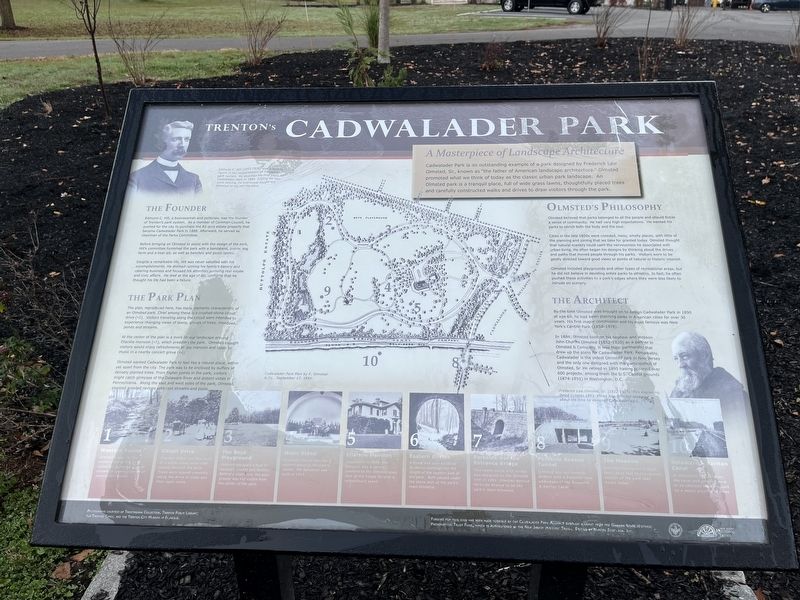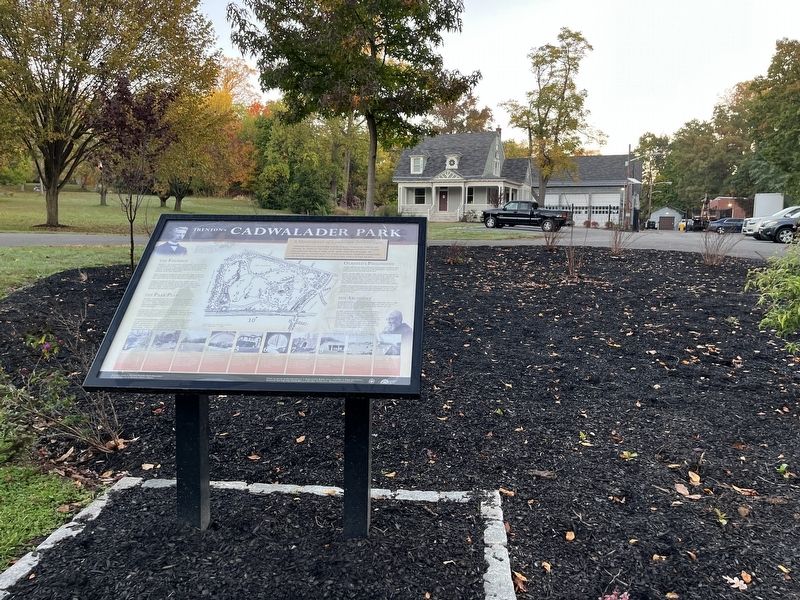Cadwalader Heights in Trenton in Mercer County, New Jersey — The American Northeast (Mid-Atlantic)
Trenton's Cadwalader Park
A Masterpiece of Landscape Architecture
Cadwalader Park is an outstanding example of a park designed by Frederick Law Olmsted, Sr., known as "the father of American landscape architecture." Olmsted promoted what we think of today as the classic urban park landscape. An Olmsted park is a tranquil place, full of wide grass lawns, thoughtfully placed trees and carefully constructed walks and drives to draw visitors through the park.
The Founder
Edmund C. Hill, a businessman and politician, was the founder of Trenton's park system. As a member of Common Council, he pushed for the city to purchase the 82-acre estate property that became Cadwalader Park in 1888. Afterward, he served as the chairman of the Parks Committee.
Before bringing on Olmsted to assist with the design of the park, Hill's committee furnished the park with a bandstand, prairie dog farm and a bear pit, as well as benches and picnic tables.
Despite a remarkable life, Hill was never satisfied with his accomplishments. He disliked running his family's bakery and catering business and focused his attention, pursuing real estate and civic affairs. He died at the age of 80, confiding that he thought his life had been a failure.
The Park Plan
The plan, reproduced here, has many elements characteristic of an Olmsted park. Chief among these is a crushed-stone circuit drive (•2). Visitors traveling along with the circuit were intended to experience changing views of lawns, groves of trees, meadows, ponds and streams.
At the center of the plan is a more formal landscape around Ellarslie mansion (•5), which predated the park. Olmsted thought visitors would enjoy refreshments at the mansion and listen to music in a nearby concert grove (•4).
Olmsted wanted Cadwalader Park to feel like a natural place, within yet apart from the city. The park was to be enclosed by buffers of densely planted trees. From higher points in the park, visitors might catch glimpses of the Delaware River and distant vistas in Pennsylvania. Along the east and west sides of the park, Olmsted planned wooded ravines with cool streams and pools.
Olmsted's Philosophy
Olmsted believed that parks belonged to all the people and should foster a sense of community. He had very high expectations. He wanted his parks to enrich both the body and the soul.
Cities in the late 1800s were crowded, noisy, smelly places, with little of the planning and zoning that we take for granted today. Olmsted thought that natural scenery could calm the nervousness he associated with urban living. He often began his designs by thinking about the drives
Olmsted included playgrounds and other types of recreational areas, but he did not believe in devoting entire parks to athletics. In fact, he often pushed these activities to a park's edges where they were less likely to intrude on scenery.
In 1884, Olmsted took on his nephew and stepson John Charles Olmsted (1852-1920) as a partner in Olmsted & Company. It was their partnership that drew up the plans for Cadwalader Park. Remarkably, Cadwalader is the oldest Olmsted park in New Jersey and the only one designed with the participation of Olmsted, Sr. He retired in 1895 having planned over 600 projects, among them the U.S. Capitol grounds (1874-1891) in Washington, D.C.
[Captions:]
Edmund C. Hill (1855-1936) was a leading figure in the establishment of Trenton's park system. He sketched the first plans for Cadwalader Park in 1889. Finding his own work lacking, he eventually sought out Olmsted to lay out the park.
Frederick Law Olmsted, Sr. (1822-1903). This engraving, dated October 1893, shows how Olmsted appeared about the time he designed Cadwalader Park.
1. Western Ravine
Olmsted's plan for the western end of the park called for damming a small stream to create a series of naturalistic pools.
2. Circuit Drive
Olmsted staked out the route of a stone-paved drive that looped through the park. Trees were spaced unevenly along the drive to close and then open views.
3. The Boys Playground
Olmsted set apart a field for baseball, cricket and football. Behind a slight rise, the playground was not visible from the center of the park.
4. Music Stand
Olmsted's design included a concert grove at the park's center. The bandshell was built in 1913.
5. Ellarslie Mansion
Completed in 1848, the mansion was a central element of the Olmsted plan. Part of the house became a refreshment stand.
6. Eastern Ravine
A brook and path bordered by dense plantings ran the length of the eastern side of the park. Both passed under the stone arch at the park's main entrance.
7. Parkside Avenue Entrance Bridge
This rustic stone-arch bridge was designed by the Olmsted firm in 1891. Olmsted wanted Parkside Avenue to be the park's main entrance.
8. Parkside Avenue Tunnel
Olmsted laid out Parkside Avenue with a beautiful new underpass of the Delaware & Raritan Canal.
9. The Meadow
Olmsted envisioned a much more open feel to the central section of the park than exists today.
10. Delaware & Raritan Canal
In Olmsted's original plan, the canal and railroad were to be shielded from the park by a dense planting of trees.
Erected by Cadwalader Park Alliance.
Topics. This historical marker is listed in these topic lists: Architecture • Parks & Recreational Areas. A significant historical year for this entry is 1888.
Location. 40° 14.192′ N, 74° 47.24′ W. Marker is in Trenton, New Jersey, in Mercer County. It is in Cadwalader Heights. Marker is on Hillvista Boulevard, 0.1 miles north of Parkside Avenue, on the right when traveling north. Touch for map. Marker is at or near this postal address: 400 Hillvista Blvd, Trenton NJ 08618, United States of America. Touch for directions.
Other nearby markers. At least 8 other markers are within walking distance of this marker. Cadwalader Park (a few steps from this marker); Mercer County Soldiers’ and Sailors’ Monument (about 300 feet away, measured in a direct line); The Swamp Angel (about 400 feet away); Briar Patch (about 400 feet away); Deer & Monkeys & Bears, Oh My! (about 400 feet away); Cadwalader Park, Trenton (about 600 feet away); Ellarslie (about 700 feet away); Before the Park (about 800 feet away). Touch for a list and map of all markers in Trenton.
Credits. This page was last revised on February 16, 2023. It was originally submitted on October 16, 2022, by Devry Becker Jones of Washington, District of Columbia. This page has been viewed 89 times since then and 21 times this year. Photos: 1, 2. submitted on October 16, 2022, by Devry Becker Jones of Washington, District of Columbia.

